Suppose that you are in Florida and you want to watch a rocket launch. In this article, I try to give you a rundown on the best locations for watching rockets launch on the “space coast”. I provide pictures and videos from each location to help you make the best decision on launch day.
There is also advice from people on Twitter to give you some indication of how to be best prepared for launch day.
This particular article was timed for the maiden launch of Falcon Heavy, so those of you who tried to catch this exciting launch in person would know exactly where to watch. However, this article is applicable for all launches from Florida. Do please note that this article will only be for Florida launches. There may be another article that is specific to launches from Vandenberg Space Force Base in California, or maybe other launch sites as well, in the future.
If your goal is to catch a SpaceX launch specifically, and need a quick rundown on “all things SpaceX”, including launch vocabulary, what rockets they launch, where they launch from and where they land, make sure to check out my complete guide to SpaceX series.
The date you see on any launch is a NET date, and that stands for No Earlier Than… This is a very important point. You should plan on rocket launch dates changing, often multiple times. The further out you are in time, for example a month or more, the more likely the date is to change. The closer you are, such as within a day, the more likely the launch is to happen as advertised. This is because there are many, many things that need to happen leading up to a launch. The rockets themselves need to arrive at their launch site, then the payload needs to arrive as well. Then the payload is connected to the rocket, and everything needs to be checked out several times before they actually give the go for launch. If at any point leading up to this, something goes wrong, the date will slip.
Apps
The best way to know how to stay tuned to launch dates is by having a few select apps installed on your phone. If you are specifically interested in SpaceX launches, then there is no better app than the SpaceX now app. This will notify you of any changes, such as any news updates from Reddit, or any official tweets from SpaceX or Elon personally.
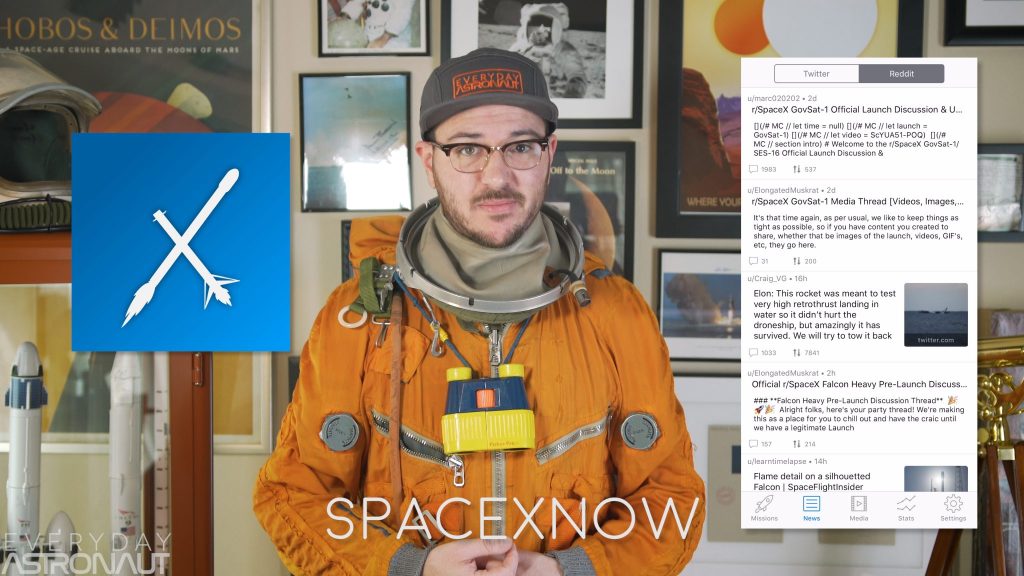
The next best app for launches on the Space Coast is the We Are Go Vacationauts app. This app is particularly suitable if you are on vacation and hoping to catch a launch. It has a great up to date launch calendar, missions with badges, quizzes, polls and so forth. It is a great way to get the most out of your vacation while being plugged into launches. This app is only specific to Florida launches though, which may or may not be a good thing, depending on what you want.
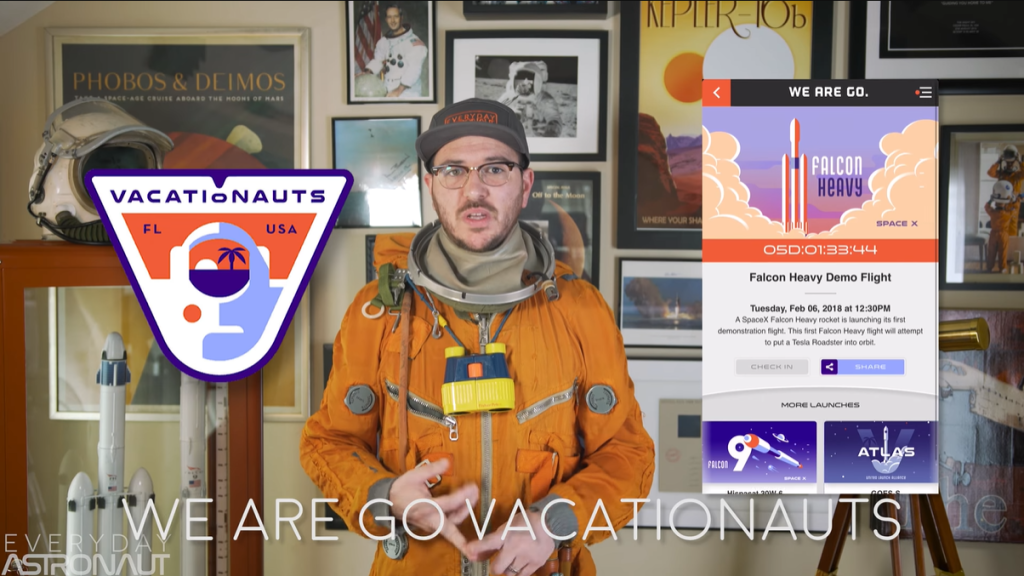
Another good app for launch dates and times is the launch alarm app. It will also notify you of any changes and has all upcoming launches, including launches not only from other US sites, but also launches from all other countries as well.

Lastly, if you are not an app person, then I recommend checking out www.Spaceflightnow.com for their fantastic “launch schedule” section as well.
Tip number 1: stay as focussed on the launch date and time in the run up to the launch as humanly possible.
Expect scrubs
Now let us talk about the actual launch day. If you have tuned in to previous launches, you know sometimes you get right down to T-0 and the rocket stays on the pad. Again, there are just so many variables, including weather, boats or airplanes wandering into the path of the rocket (despite massive fines), and any mechanical issues that might pop up last minute as the rocket is loaded with propellants and is prepared for launch.
So the moral of the story is, you are not really going to see a rocket launch. You are going to try to see a rocket launch. This might sound harsh, but it is just simply the reality of it. Rockets are not like trains, buses, boats or airplanes with a fixed schedule. So it is best not to hold your breath until you see the rocket leave the launch pad.
Tip number 2: Plan on a scrub (or delay of an entire day, or more than one day), and only be extra surprised if one does not happen. Hopefully, for everyone’s sake, the delay is only a single day and not some major setback of days or weeks.
Online launch streams
So now you know when a rocket is going to launch. But where should you go to see a rocket launch? If you are not in the Florida area, then you can tune into YouTube for the easiest launch experience. Subscribe to SpaceX, ULA, NASA, Northrop Grumman, (formerly Orbital ATK), Rocket Lab, ESA, Blue Origin or any other of your favorite launch providers or agencies if you want to be notified when they will go live.
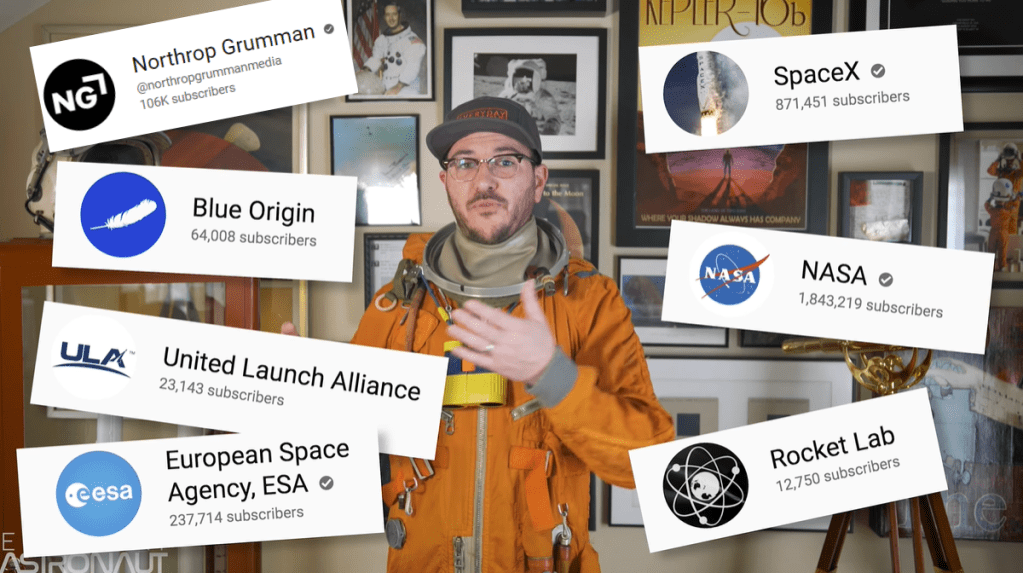
But, perhaps even more fun, you can join me during my live streams when I cover launches. I am usually available at around T-minus 30 minutes for most launches covered, to answer your questions live. So make sure that you are subscribed here so you know when that will occur. When I attend a launch in person, I will be live streaming from Kennedy Space Center’s press site as well, so you’ll get an excellent live view from only 3 miles away. Please note – since this article was first published, the number of launches per year has increased, and I have less free time to stream launch coverage than I may have had in the past.
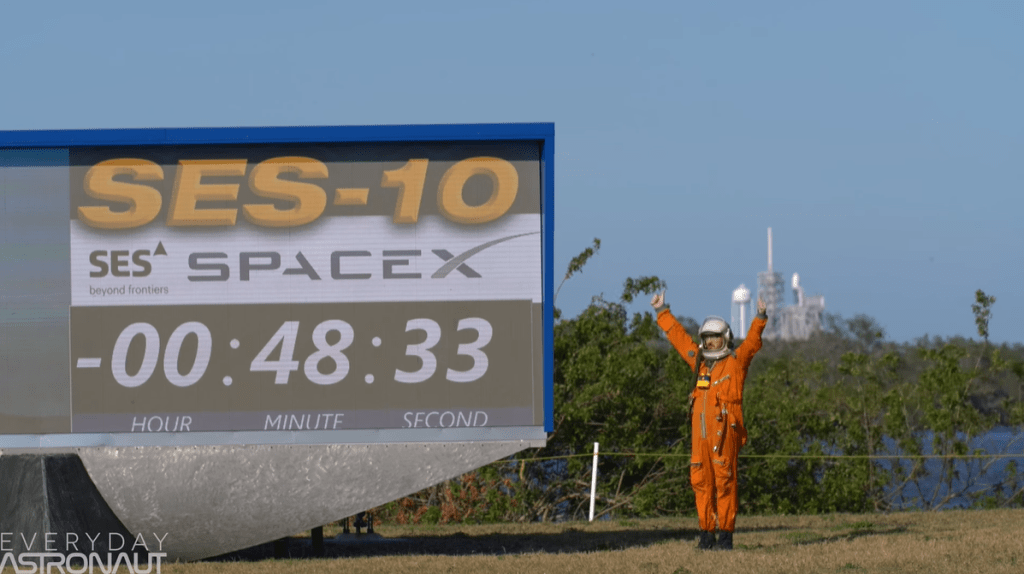
It’s as easy as that for online. But if you are trying to see it in person, we need to do a quick summary of the different launch sites and the landing pads.
Space Coast Launch Pads

SpaceX launches its Falcon Heavy from Historic Launch Pad 39A in Kennedy Space Center. Nearby to that is NASA’s 39B where SLS is launched. Then down South we have, in order from North to South:
- SLC-41 where ULA launches their Atlas V rocket
- SLC-40 where SpaceX launches their Falcon 9 rocket
- SLC 37 where ULA launches Delta IV and Delta IV heavy, and of course:
- Landing Zone 1 or LZ-1 and LZ-2 which is right next to it. That’s right, landing zones because this is where SpaceX lands their Falcon 9 and Falcon Heavy boosters.
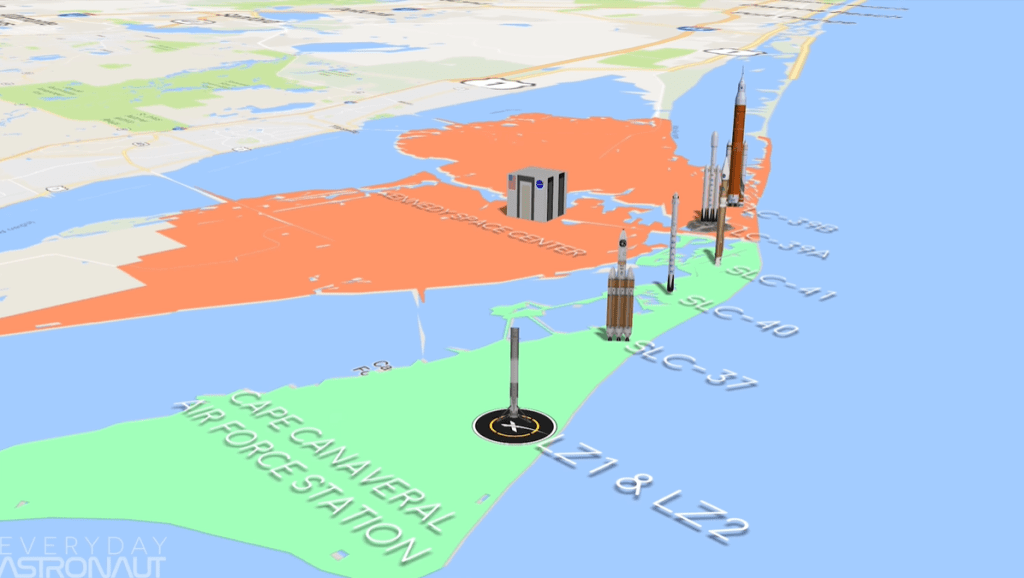
Kennedy Space Center locations
There are several places to view launches from, some closer than others, but closer might not always be better due to obstructed views.
Here is a rundown on the most common public places. For most launches, if you are early enough, you can buy tickets directly from Kennedy Space Center’s Visitor Complex. This can offer you the best views from inside NASA’s Kennedy Space Center. The options vary depending on the nature of the launch. There are three different options that might be available that actually get you inside the gates of the space center and beyond the visitors’ center.
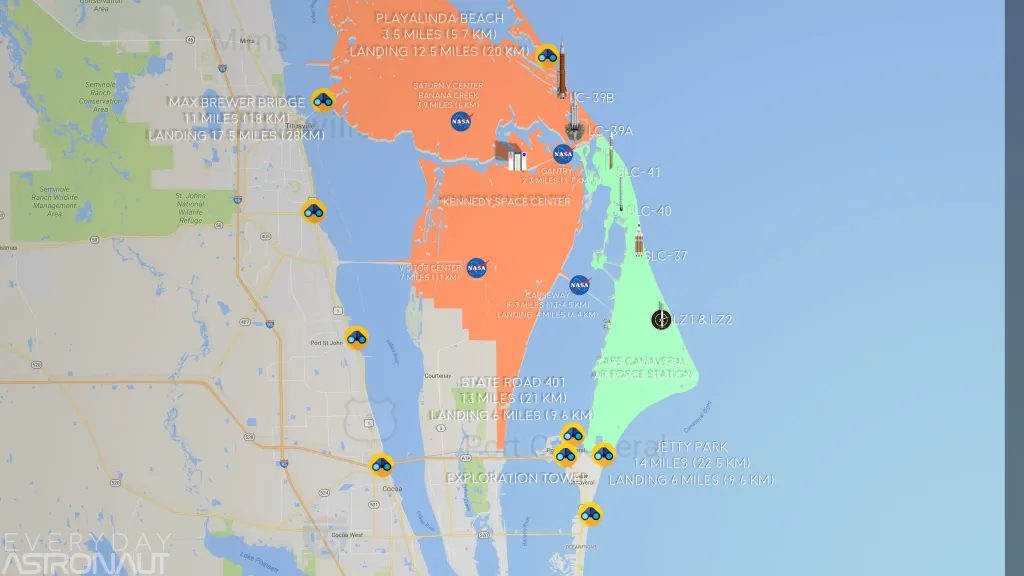
First off, there is the Saturn V center, which is easily one of the best views the general public can get, especially for pads 39A and 39B. At just 3.9 miles, or 6 km, away from 39A, this is easily one of the best views in the house for SpaceX launches from 39A.
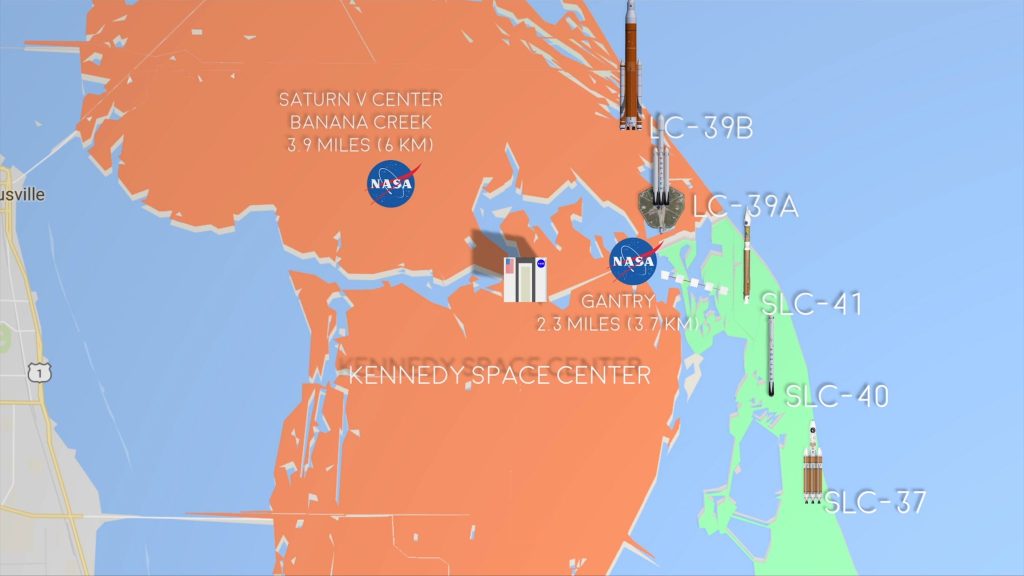
Then there is the gantry. This place is very close to SLC-41 which is used for Atlas V launches. At only 2.3 miles or 3.7 km away, this site can be quite the experience. It is not always available as an option, however, so do please check before traveling.

Lastly, there is the causeway This offers a good view of all the launch pads, ranging from 8 miles or around 13 km away from 39B and just under 3 miles or 4.5 km away from SLC-37. This is the closest you can get to the landing pad at just 4 miles or 6.4 km away. This location is not often available except for high profile NASA launches, or for accredited press only.
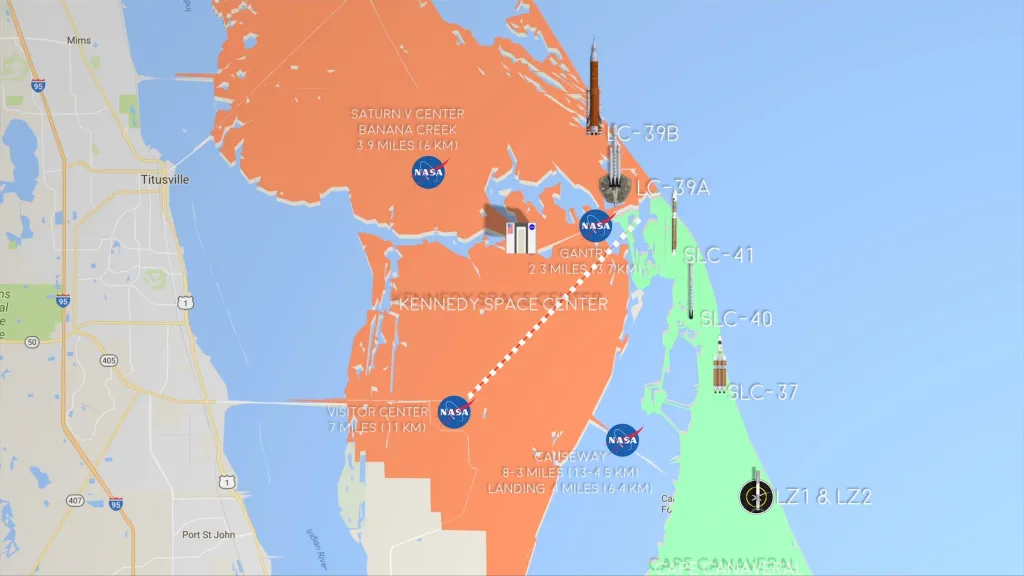
Otherwise, for most launches, you can watch from the visitors’ center. Although it doesn’t offer a direct line of sight to the launch pads due to trees being in the way, it does have bleachers, jumbotrons, guest speakers, and of course, excellent amenities.
You will get a great view once the rocket leaves the pad at around 7 miles or 11 km away from most launch pads. Then you can purchase tickets by visiting www.kennedyspacecenter.com and clicking on tickets. These usually become available approximately two weeks before launch.
Other viewing locations

The next most common option, and possibly an even better option is Jetty Park in Port Canaveral. Although Jetty Park is 14 miles or 22.5 km away from 39A, and although you are not able to see ignition due to a berm that blocks a direct line of site to the launch pad, at just 6 miles or 9.6 km away from the landing pad, Jetty Park is quite the experience.
It will be crowded. This is one of the most popular spots to view from as it is technically the closest and best view you can get to the landing pad. This does not apply for launches that are landing down range on a drone ship, or for an expendable launch vehicle like rockets that are not from SpaceX. This location has restrooms, and a restaurant as well. It costs around $15 per car and will fill up quickly, so make sure that you get there as early as you can.
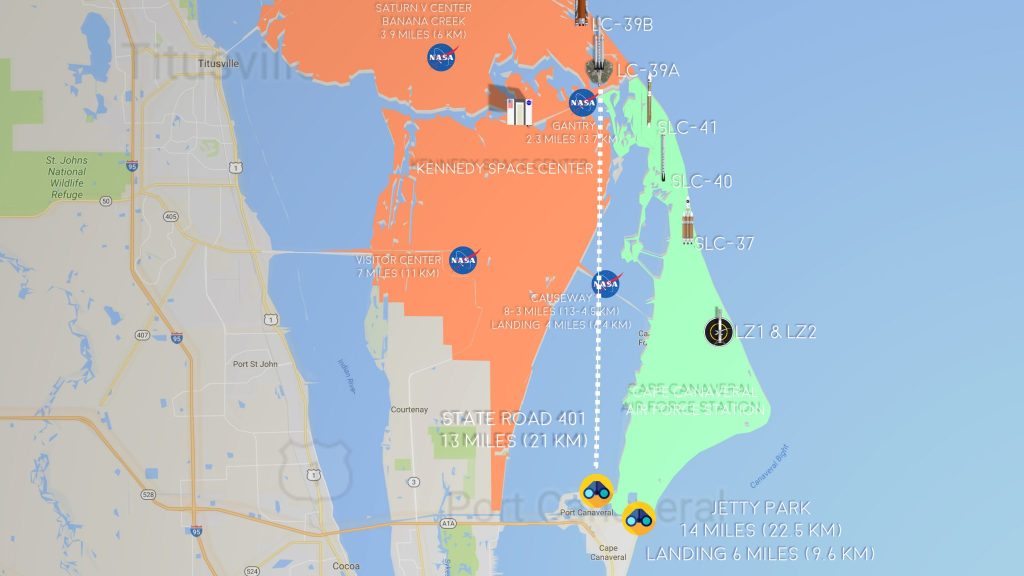
The next most common public view is from State Road 401, at the southern entrance to Cape Canaveral Air Force station. This is perhaps one of your best views of the launch pad itself if seeing the rocket at ignition is important to you. At just 13 miles or 21 km, you are looking directly over the Banana river straight to Pad 39A and have pretty great views of the other launch sites as well. It’s also a pretty good place to see the landings.
The only issue with this vantage point is there can be a very large building that partially obscures the view of the landings, but at 6 miles or 9.6 km’s away, you are pretty darn close. Again, plan on this area being really really busy.
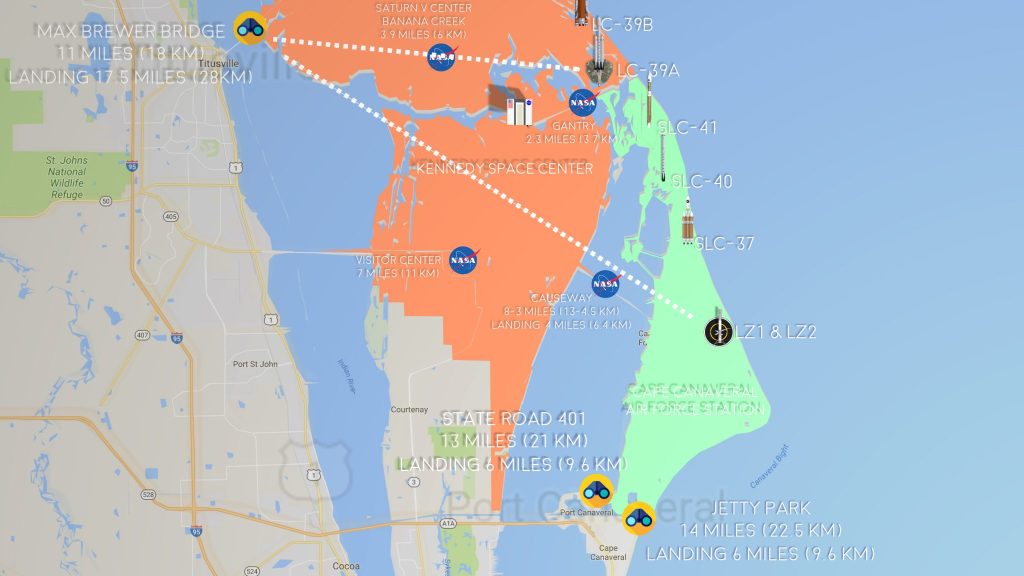
Next, we have another option that’s great for launches out of pad 39A, like Falcon Heavy. It’s the Max Brewer Bridge. It offers an elevated view that’s pretty darn close too.
At 11 miles or 18 km, you get a really good view of the takeoff. But you are about as far away from landings as possible. At 17.5 miles or 28 km away, you won’t get nearly as much out of the landing experience.

Next up, we have the closest the general public can get to launches. This location is not always an option, and you should be aware that does it have some drawbacks. Playalinda beach is only 3.5 miles or 5.7 km from Pad 39A, which means it most likely will not be open for Falcon Heavy launches.
But it is an excellent choice for other launches. It is however very far away from the landing site again, at 12.5 miles or 20 km’s away. But remember, most rockets don’t land back at land, most land at sea or don’t land at all, so perhaps this excellent view of the pads is well worth it. Another bad thing is its remote with little to no cell phone service. It also has very limited bathrooms and zero amenities otherwise.
Visit this National Park Service website, or call this phone number (321) 267-1110 if you’d like to see if Playalinda beach is open for the launch you are trying to attend.
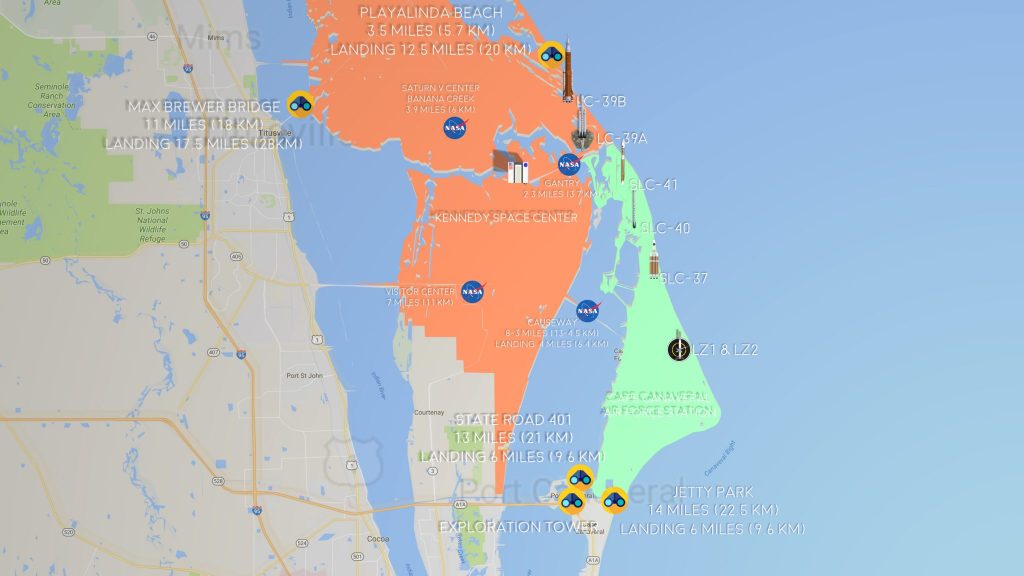
Next up we have Exploration Tower which is not always open for launches, but if you have the opportunity, definitely check it out. It is open from 10:00 am to 5:00 pm and sometimes as late as 7:00 pm. It offers an excellent view of all launch pads and the landing zone. It is inexpensive as well – only $15 on launch days for adults. However, it is not always available to the public on launch days as occasionally SpaceX uses it as a press site.

There are also many parks and other places along Highway 1 which runs along the Indian River. They tend to offer decent views and you may be close enough to different amenities that you can easily park and walk to grab food or find a restroom.

And lastly, if you are pretty much anywhere along the beach from Cape Canaveral down to Cocoa Beach, you will for sure be able to see it. Just not as well as other places. It is difficult to beat swimming in the ocean while watching a rocket launch over you – or maybe hanging out on Cocoa Beach Pier for the entertainment and restaurants overlooking a launch.
So if this is all overwhelming, please check out launchrats.com. LaunchRats has plotted out many different places to view launches. If you want a great resource to be able to quickly look at and plot your next move, this is highly recommended.
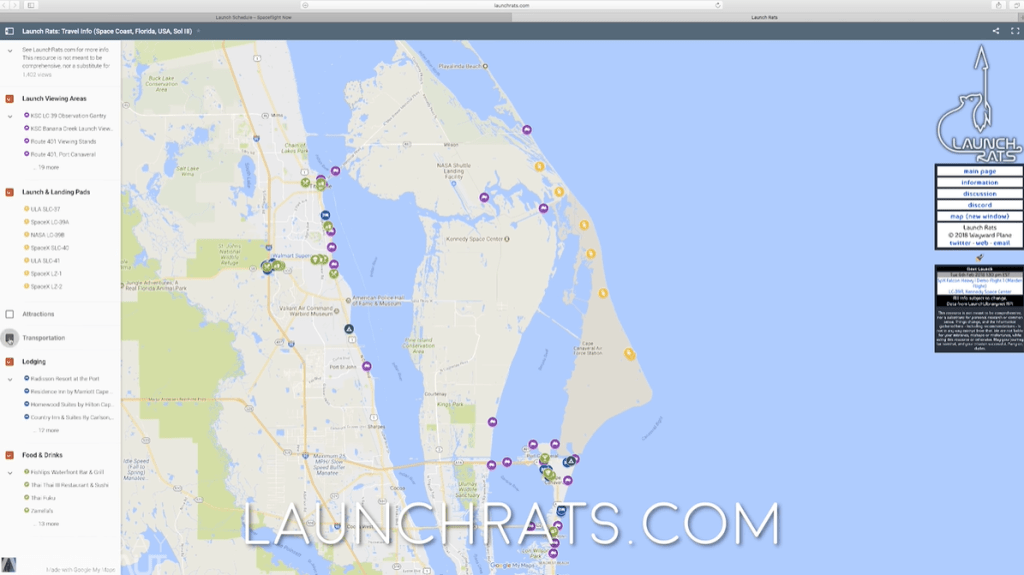
Another great website is professional launch photographer Ben Cooper’s Rocket Launch viewing guide for Cape Canaveral on his website launchphotography.com.
Tip number 3: know where you are going, and get there early.
Advice And Tips

I asked my followers on Twitter to offer their best tips for viewing a launch. Here are a few of the favorite responses: my friends the Nagels said “We pack the minivan with bicycles, chairs, cooler, binoculars, and lots of water. We arrive at the coast very early, set up camp and then bike to breakfast, lunch etc. Early arrival is key and not be in a hurry to leave after. The social aspect is half the fun.”

Carolyn Hutchins also recommended getting their early to stake your spot out first. Bring a picnic lunch too!

Trip Harris suggested “If you’ve never seen a launch, leave your camera at home and instead just watch it with your own eyes. There will be plenty of great photos available from guys like @johnkrausphotos anyways. :)”
This “leave your camera at home” mantra was echoed over and over again.

Julia expanded the importance of living in the moment by saying “Enjoy the experience. What did you see, hear, feel? A picture is just a moment but a launch is so much more. The person standing next to you? Say hello- you may find they worked on the Shuttle or Apollo program. Launches are a shared experience. Enjoy!”
That last part is especially important: meet people. You are all there for the same thing – to witness the magic of spaceflight. To watch a rocket break Earth’s gravity and propel itself towards the heavens. To inspire each other and share the moment together.
As a former professional photographer, I agree with this. By all means, snap one picture with your phone or put a camera on a tripod and click it once. But do not worry about your grainy cell phone picture and instead, take in the experience.

Pat o. said “Be prepared for a spectrum of emotions! The pre-launch hype, the chance for a disappointing scrub, the intensity when it actually launches, and the sadness when it’s over!”

Fellow space journalist, Robin Seemangal suggested “Mosquito repellent. Lots and lots of mosquito repellent. And snacks”.

Holly recommended downloading a scanner app to listen to “Kennedy Space Center Communications” to get an accurate listen to the countdown and some of the launch prep.

Cathy had a friendly reminder about trash – “PLEASE pick up your trash! KSC is in the middle of a federally protected wildlife area and people need to respect that.”

Finally, my favorite YouTube space show, TMRO, had the ultimate advice – “Don’t stand next to the rocket at liftoff.” Thank you guys.
Tip number 4: Get there early, bring food, water, maybe a bike or two, some comfy chairs, sunscreen, insect repellant, and perhaps leave your camera at home!
I hope that all of this information helps you be as prepared as humanly possible for Space Coast launches.




